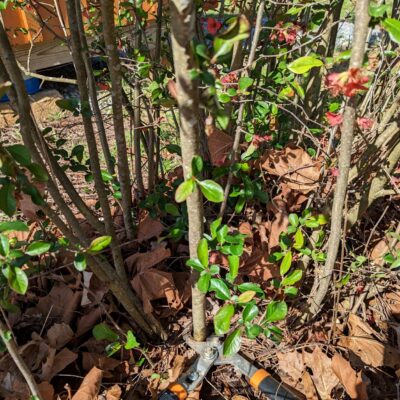Sometimes, perhaps more often than not, neglected plants will grow in a way that is not always optimal. Before we get to restorative pruning, there are a few things you need to know about how trees and shrubs grow.
The first is the concept of apical dominance, that is, when the leader in a tree takes the lead in growth. Heading cuts remove the branch tips which suppress the buds further down. When the apical bud is removed, the lateral buds begin to grow. This leads to a denser tree or shrub.
The second concept is that many shrubs (but not all) set their floral buds in the previous growing season. Shearing plants late in the season removes the following years flower buds. Get to know your plants to know if it’s okay to cut back plants late in the season. Some plants that form buds in the same year (on new wood) can be cut back late in the year or early in the spring. These include butterfly bush (Buddleia spp.), crape myrtle (Lagerstroemia spp.), Hydrangea (Hydrangea paniculata and H. arborescens), Rose-of-Sharon (Hibiscus syriacus), roses (Rosa spp.), and fig (Ficus carica).
If you are not sure whether your plant has set floral buds on previous season wood, then put away the hedge shears and work with pruners. Prune out the oldest stems to keep plants healthy and flowering. In any given year, remove only one third of the oldest wood. The focus is to open the center of the plant to allow in light and to improve air circulation. This technique will help reduce disease in susceptible plants by allowing the foliage to dry faster. Additionally, thinning plants will increase the formation of floral buds along the stem receiving light.
Finally, don’t think that you have to fix faults in one go. Restorative pruning takes time. Just work with the plant.
Some Shrubs that Set their Floral Buds in the Prior Growing Season
- Bigleaf Hydrangea (Hydrangea macrophylla)
- Chokecherry (Aronia)
- Climbing hydrangea ( petiolaris)
- Elderberry (Sambucus)
- Forsythia (Forsythia x intermedia)
- Hazelnut (Corylus)
- Lilac (Syringa vulgaris)
- Ninebark (Physocarpus opulifolius)
- Oakleaf Hydrangea ( quercifolia)
- Rhododendron (Rhododendron)
- Viburnum (Viburnum)
Pruning a one-sided Saucer magnolia
This tree was suppressed by a large Callery pear, which was subsequently removed. Most of its branching structure grew to one side. Wait until the tree has finished flowering before any restorative work. In this case, low overnight temperatures shortened the floral display. Historically, the plant was headed back. Indicative are the crowded, spindly branch structure. We’ll focus on removing the following:
- Crowded/redundant branches
- Spindly (lacking taper) branches
- Crossed branches
- Dead and diseased branches
- Branch stubs
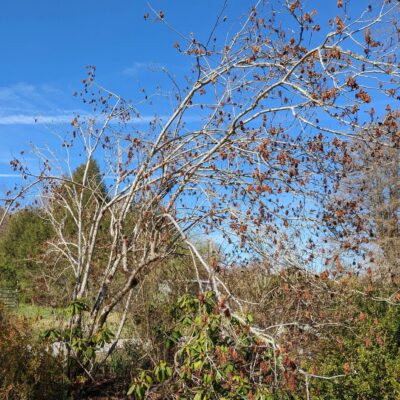
Make the first two cuts to remove branch weight. Do this by cutting 12 to 18” out from the tree. Make an undercut one third up the branch, then a top cut to remove the branch. The final cut is along the branch-bark ridge.


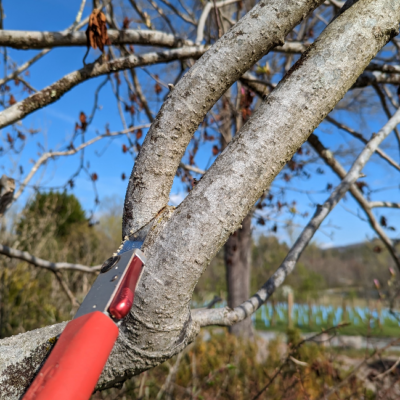
Next remove diseased, dying, and dead branches.

Remove inward growing and crossing branches.
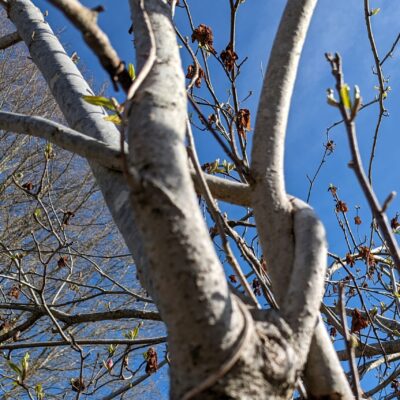
Skeletal pruning focuses on improving tree structure by removing multiple branches arising from a single point.

Allow the tree to begin to restore a symmetrical crown. This will take some time. Next year, we’ll revisit the tree to help steer its restoration.
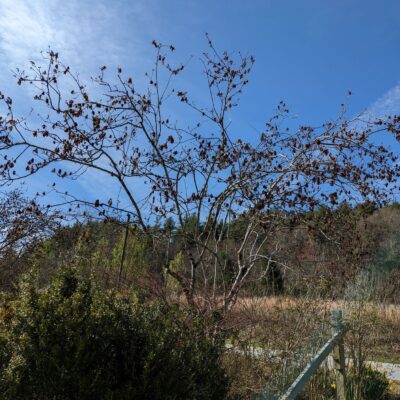
Pruning a neglected quince (Chaenomeles speciosa)
Quince is an early blooming shrub. It sets its floral buds on old wood. Wait until the plant has finished flowering, or prune when flowering to take cuttings for a floral arrangement! Remove up to one third of the oldest (internal) canes, cutting as low to the ground as possible. Using loppers makes it a bit easier.
To control its height and girth, use a hand pruner last to make heading cuts to bring the plant within bounds. Prune back to an outside bud.

Use these two techniques (thinning & heading cuts) to keep the natural shape of the shrub. This technique lends itself to a naturalistic design.

Next week we’ll discuss another group of flowering trees: apples. We’ll discuss different varieties and how to care for them.
~ Signing off for now, Joe


